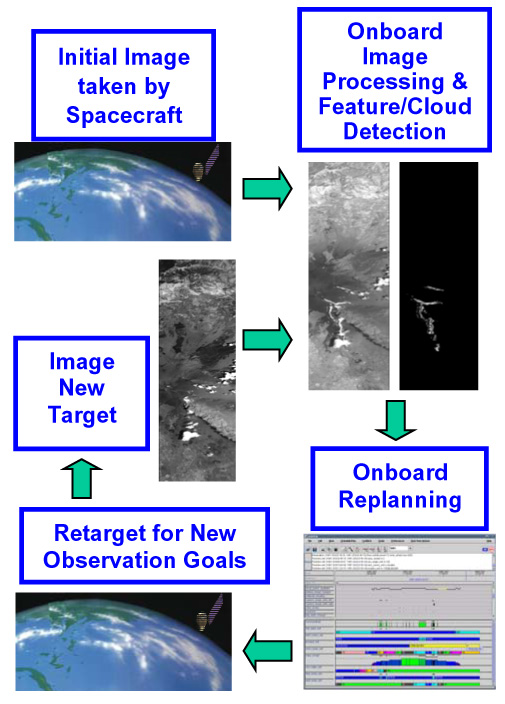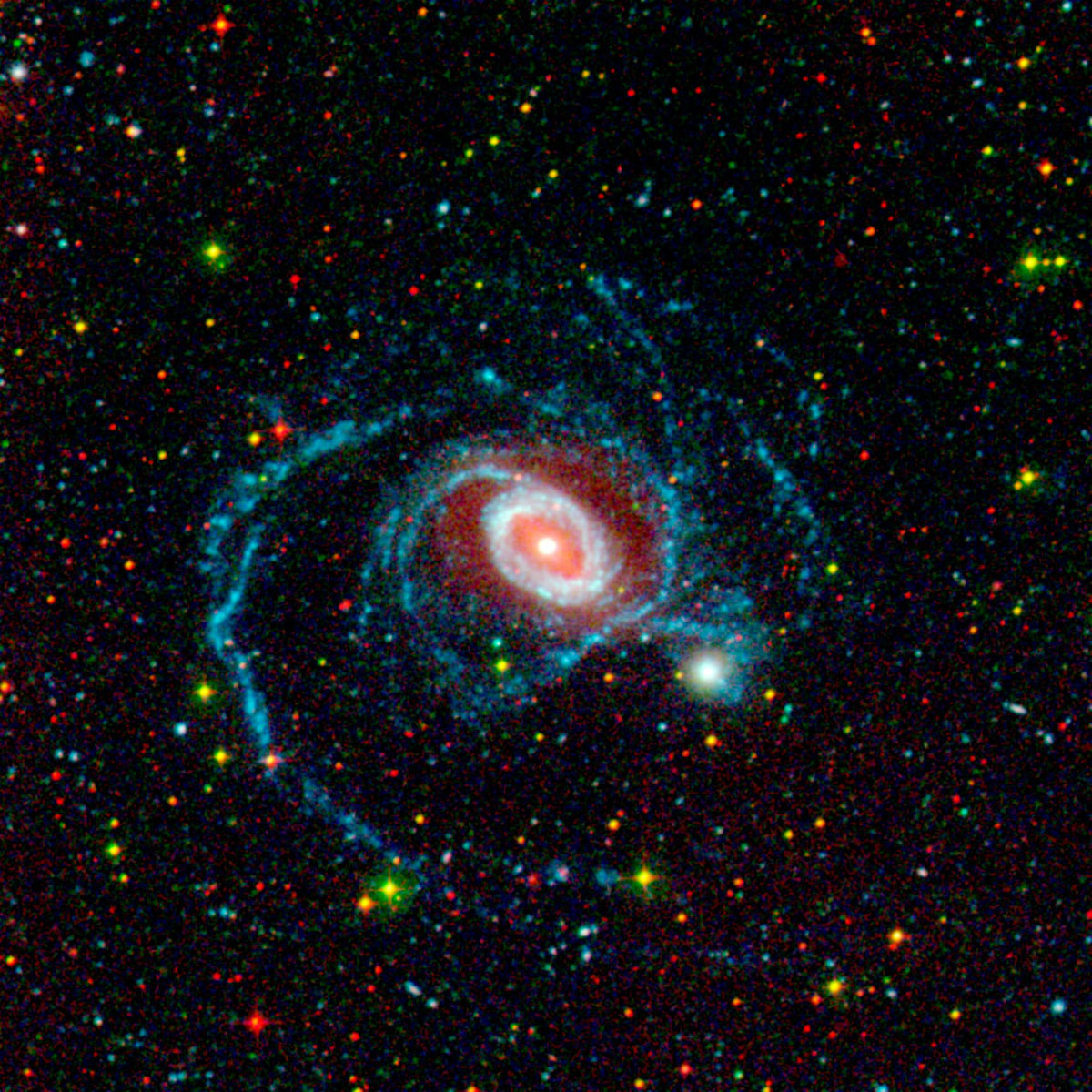Next Launch
Total Students
2,609
Total Launches
683
Eggs Survived
418 61.2%
Rockets Survived
536 78.5%
Oct. 1, 2007
The Red (Hot?) Planet
by Patrick L. Barry
Don't let Mars's cold, quiet demeanor fool you. For much of its history, the Red Planet has been a fiery world.
Dozens of volcanoes that dot the planet's surface stand as monuments to the eruptions that once reddened Mars's skies with plumes of glowing lava. But the planet has settled down in its old age, and these volcanoes have been dormant for hundreds of millions of years.
Or have they? Some evidence indicates that lava may have flowed on Mars much more recently. Images of the Martian surface taken by orbiting probes show regions of solidified lava with surprisingly few impact craters, suggesting that the volcanic rock is perhaps only a million years old.
If so, could molten lava still occasionally flow on the surface of Mars today?
With the help of some artificial intelligence software, a heat-sensing instrument currently orbiting Mars aboard NASA's Mars Odysseyspacecraft could be just the tool for finding active lava flows.
"Discovering such flows would be a phenomenally exciting scientific finding," says Steve Chien, supervisor of the Artificial Intelligence Group at JPL. For example, volcanic activity could provide a source of heat, thus making it more likely that Martian microbes might be living in the frosty soil.
The instrument, called THEMIS (forThermal Emission Imaging System), can "see" the heat emissions of the Martian surface in high resolution—each pixel in a THEMIS image represents only 100 meters on the ground. But THEMIS produces about five times more data than it can transmit back to Earth.
Scientists usually know ahead of time which THEMIS data they want to keep, but they can't plan ahead for unexpected events like lava flows. So Chien and his colleagues are customizing artificial intelligence software called ScienceCraft to empower THEMIS to identify important data on its own.
This decision-making ability of the ScienceCraft software was first tested in Earth orbit aboard a satellite called Earth Observing-1 by NASA's New Millennium Program. Earth Observing-1 had already completed its primary mission, and the ScienceCraft experiment was part of the New Millennium Program’s Space Technology 6 mission. On Odyssey, ScienceCraft will look for anomalous hotspots on the cold, night side of Mars and flag that data as important. "Then the satellite can look at it more closely on the next orbit," Chien explains.
Finding lava is considered a long shot, but since THEMIS is on all the time, "it makes sense to look," Chien says. Or better yet, have ScienceCraft look for you—it’s the intelligent thing to do.
To learn more about the Autonomous ScienceCraft software and see an animation of how it works, visit http://ase.jpl.nasa.gov.
This article was provided by the Jet Propulsion Laboratory, California Institute of Technology, under a contract with the National Aeronautics and Space Administration.
 Just as changing cloud patterns on Earth were identified using Earth Observing-1’s Advanced
Land Imager along with ScienceCraft software, the THEMIS instrument with ScienceCraft on the
Mars Odyssey spacecraft can avoid transmitting useless images.
Just as changing cloud patterns on Earth were identified using Earth Observing-1’s Advanced
Land Imager along with ScienceCraft software, the THEMIS instrument with ScienceCraft on the
Mars Odyssey spacecraft can avoid transmitting useless images.
Nov. 1, 2007
Going My Way?
by Diane K. Fisher
Not many endeavors require that you plan the mode of transportation before you even know what it is you are transporting. But weighing the physics and economics of getting any sort of cargo to space is a major part of designing a space mission.
It's one of the first issues that NASA's New Millennium Program (NMP) considers when planning a new mission. NMP has the forward-looking job to identify promising new technologies for space exploration. It then helps to mature the technology so it will be available to space missions of the future. If the technology cannot be tested adequately on Earth, the last part of this process is to actually send the technology into space. With carefully documented test results, future mission planners can confidently incorporate the new technology into their designs.
But where to begin? On call from the start, Linda Herrell is the New Millennium Program Architect. Given a list of proposed technologies, she has the job of figuring out the feasibility of wrapping a mission around them.
"We might be considering six or more technologies, anything from solar panels to imagers to masts for solar sails to more intelligent software. Of those, we may choose four. My job is to answer the question—can the selected technology be transported to and operated in space within the constraints of a low-cost technology validation project?"
Along with the list of possible mission payloads (the technologies), Linda also has a list of spacecraft to put them on, as well as a list of launch vehicle parameters. All she has to do is try them out in every possible combination (of which there are thousands) and see what might work.
"Fortunately, we have a software tool to help with this analysis," says Linda. When it comes down to it, her job is primarily to figure out how to get the technologies into space.
"Sometimes, it's like figuring out how to get across town when you don't have your own car. You have to get creative."
She keeps a database of all possible options, including riding piggyback on another spacecraft, hitching a ride on a launch vehicle as a secondary payload, or sharing a launch vehicle with other NASA, Department of Defense, or even commercial payloads.
Her assessment is but one of a gazillion factors to be considered in planning a mission, but it is indeed one of the very first "details" that forms the foundation for the rest of the mission.
Find out some of the technologies that NMP has already validated or is considering at https://www.jpl.nasa.gov/nmp/TECHNOLOGY/missions.php. Kids will enjoy watching Linda's cartoon alter-ego talk about her job at spaceplace.nasa.gov/en/kids/live.
This article was provided by the Jet Propulsion Laboratory, California Institute of Technology, under a contract with the National Aeronautics and Space Administration.
 NASA’s New Millennium Program selects breakthrough technologies that will be of the greatest use to future space and Earth science missions and that are perceived to be risky to the first user.
NASA’s New Millennium Program selects breakthrough technologies that will be of the greatest use to future space and Earth science missions and that are perceived to be risky to the first user.
Dec. 1, 2007
Challenge Yourself with Weather Slyders
by Sam Scijinks
The Dust Bowl. Hot, loopy solar gases. Killer Katrina. Combining dramatic images of Earth and space weather with the challenge of an old-fashioned slider puzzle, the new "Slyder" game on the SciJinks Weather Laboratory website will capture the attention of any middle-schooler--and maybe even their parents and teachers.
Players pick from a rich variety of captioned images, including photos from the ground, photos from space, and artist's renderings. After picking a difficulty level (3x3, 4x4, 5x5 grids), the player slides the scrambled tiles around to make a whole picture again. Go to http://scijinks.gov/weather/fun/slyder to become the newest Slyder buff!
This article was provided by the Jet Propulsion Laboratory, California Institute of Technology, under a contract with the National Aeronautics and Space Administration.
 Jagged lightning strokes connecting sky and Earth…
Jagged lightning strokes connecting sky and Earth…
Feb. 1, 2008
Invisible Spiral Arms
by Patrick Barry
At one time or another, we've all stared at beautiful images of spiral galaxies, daydreaming about the billions of stars and countless worlds they contain. What mysteries—and even life forms—must lurk within those vast disks?
Now consider this: many of the galaxies you've seen are actually much larger than they appear. NASA's Galaxy Evolution Explorer, a space telescope that “sees” invisible, ultraviolet light, has revealed that roughly 20 percent of nearby galaxies have spiral arms that extend far beyond the galaxies' apparent edges. Some of these galaxies are more than three times larger than they appear in images taken by ordinary visible-light telescopes.
“Astronomers have been observing some of these galaxies for many, many years, and all that time, there was a whole side to these galaxies that they simply couldn't see,” says Patrick Morrissey, an astronomer at Caltech in Pasadena, California, who collaborates at JPL.
The extended arms of these galaxies are too dim in visible light for most telescopes to detect, but they emit a greater amount of UV light. Also, the cosmic background is much darker at UV wavelengths than it is for visible light. “Because the sky is essentially black in the UV, far-UV enables you to see these very faint arms around the outsides of galaxies,” Morrissey explains.
These “invisible arms” are made of mostly young stars shining brightly at UV wavelengths. Why UV? Because the stars are so hot. Young stars burn their nuclear fuel with impetuous speed, making them hotter and bluer than older, cooler stars such as the sun. (Think of a candle: blue flames are hotter than red ones.) Ultraviolet is a sort of “ultra-blue” that reveals the youngest, hottest stars of all.
“That's the basic idea behind the Galaxy Evolution Explorer in the first place. By observing the UV glow of young stars, we can see where star formation is active,” Morrissey says.
The discovery of these extended arms provides fresh clues for scientists about how some galaxies form and evolve, a hot question right now in astronomy. For example, a burst of star formation so far from the galaxies' denser centers may have started because of the gravity of neighboring galaxies that passed too close. But in many cases, the neighboring galaxies have not themselves sprouted extended arms, an observation that remains to be explained. The Galaxy Evolution Explorer reveals one mystery after another!
“How much else is out there that we don't know about?” Morrissey asks. “It makes you wonder.”
Spread the wonder by seeing for yourself some of these UV images at www.galex.caltech.edu. Also, Chris Martin, principle scientist for Galaxy Evolution Explorer —or rather his cartoon alter-ego—gives kids a great introduction to ultraviolet astronomy at spaceplace.nasa.gov/en/kids/live#martin.
This article was provided by the Jet Propulsion Laboratory, California Institute of Technology, under a contract with the National Aeronautics and Space Administration.
 In this image of galaxy NGC 1512, red represents its visible light appearance, the glow coming from older stars, while the bluish-white ring and the long, blue spiral arms show the galaxy as the Galaxy Evolution Explorer sees it in ultraviolet, tracing pr
In this image of galaxy NGC 1512, red represents its visible light appearance, the glow coming from older stars, while the bluish-white ring and the long, blue spiral arms show the galaxy as the Galaxy Evolution Explorer sees it in ultraviolet, tracing pr